 |
"They say, 'What! When we are bones and crumbled dust, will we then be raised up as a new Creation!' Say: 'It would not matter if you were rock or iron or indeed any created thing that you think is harder still!' They will say, 'Who will bring us back again?' Say: 'He Who brought you into being in the first place'..." (Surat al-Isra', 49-51)
These verses refer to the petrification of dead bodies and how these corpses, over time, turned into iron. Living tissue is not preserved over millions of years – which is why it is only possible to clearly see creatures of the past today once they have been fossilized. After they die, living things can be preserved for millennia by the fossilization process, by their bodies literally turning into stone under the ground. The word "fossil" refers to "the preservation of a living thing by petrification," by its turning into stone.
 |
A petrified fossil sea shell dating back millions of years with iron remains that have formed over it |
Iron is preserved undamaged in the body as the body becomes fossilized. Human beings need to consume an average of 10-15 milligrams of iron a day in order to be healthy. Any excess iron consumed is stored in the liver. In addition, the protein transferred in blood plasma also carries a certain amount of iron.1 The reference in the verse to the presence of iron in the remains of the human body is exceedingly wise from that point of view.
Research has also shown the presence of "pyrite," (FeS2) a compound of iron and sulfur, in fossils.2 The iron sulfide forms very easily during the degradation of organic substances. It is therefore generally found in fossil shells and is capable of damaging the fossils since it can react with oxygen and water. The words "crumbled dust" in the verse may be a reference to "pyrite degradation," which leads to the fragmentation and collapse of a fossil as pyrite reacts with water and oxygen.3
Another fact confirmed by recent findings is that matter constantly seeks the most stable state.
This is the very nature of matter. Therefore, given sufficient time, all matter will eventually turn into iron. Iron is the most stable state of nuclear matter. In fact, cosmologists predict a stage in which everything we know will turn into iron as a result of nuclear fusion and nuclear fission reactions.4 In his book In Search of Schrödinger's Cat: Quantum Physics And Reality, the astrophysicist John Gribbon describes how iron is the most desirable state of matter and how all matter in the universe wants to turn into iron.5
The revelation in the Qur’an about human remains petrifying and fossilizing leading to an iron-dominant state, is a fact that has now been scientifically confirmed. In the same way that no archaeological, paleontological, geological or astronomical research was possible at the time the Qur'an was revealed, neither was it possible to identify the elements using an electron microscope. Thus, the facts revealed in the verse in Surat al-Isra’ once more confirm that the Qur'an is a divine text.
 |  |
A 125-million-year-old fossil tortoise (left) | It is identical to the present-day turtle (right). |
 |
We gave David great favor from Us: "O mountains and birds! Echo with him in his praise!" And We made iron malleable for him: (Surah Saba', 10)
There is a strong possibility that the description of mountains "echoing" in the above verse may refer to the workings of a modern radio. (Allah knows the truth.) The basic principles on which radios operate may be summarized as follows:
A radio system consists of a transmitter and a receiver. The transmitter takes the message to be sent, encodes it in what is known as a "sine wave" and transmits it in the form of waves through the air. The receiver takes in the radio waves and deciphers the message sent on the sine wave. In this way, the message is received in exactly the same form as it was sent. The word "awwibee," translated as "echo" in the above verse and meaning "sound being repeated or returned", may very well be a reference to the transmission of these radio waves. (Allah knows the truth.)
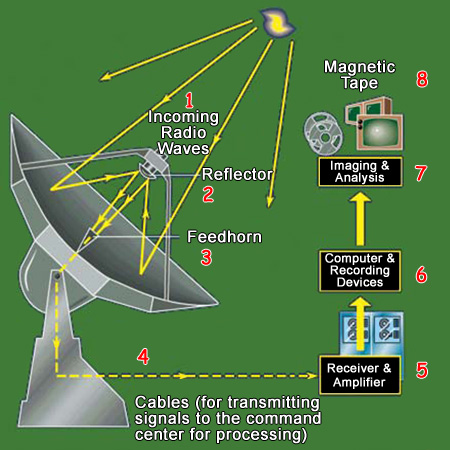 | |
1. Incoming Radio Waves | 5. Receiver and Amplifier |
Sounds are emitted in the form of sound waves by way of an antenna. This is in order that the receiver can take in the data which has been sent via an antenna linked to the receiver. The purpose behind using antennae is the transmission into space of the waves emitted by the radio transmitter. The receiving antenna is intended to collect as many radio waves and messages as possible. This is why NASA uses giant antennae dishes 70 meters across for its satellites millions of kilometers away in space.
There are also radio telescopes which can use radio waves to form images. Since radio waves are very long, a radio telescope has to be much larger in order to collect them as clear images. In order to obtain sharper and better images, astronomers use a connected series of smaller telescopes or receptors. These telescopes act collectively as one very large device – almost like a team, each with its own role. In their physical appearance, these antennae series resemble mountain systems.
In addition, "repeaters" are employed to permit radio communications over great distances. These devices repeat and strengthen weak signals and enable them to be transmitted over considerable distances. Such devices are generally sited on tall buildings or preferably on the tops of mountains, in order to have the greatest effect. The use of the word "awwibee," translated as "echo" in the above verse, is exceedingly wise. The statement of, "O mountains and birds! Echo with him in his praise!'" in verse 10 of Surah Saba' may be a description of that technology. (Allah knows the truth.)
 |
This NASA photograph shows the Apollo 12’s S band antenna. |
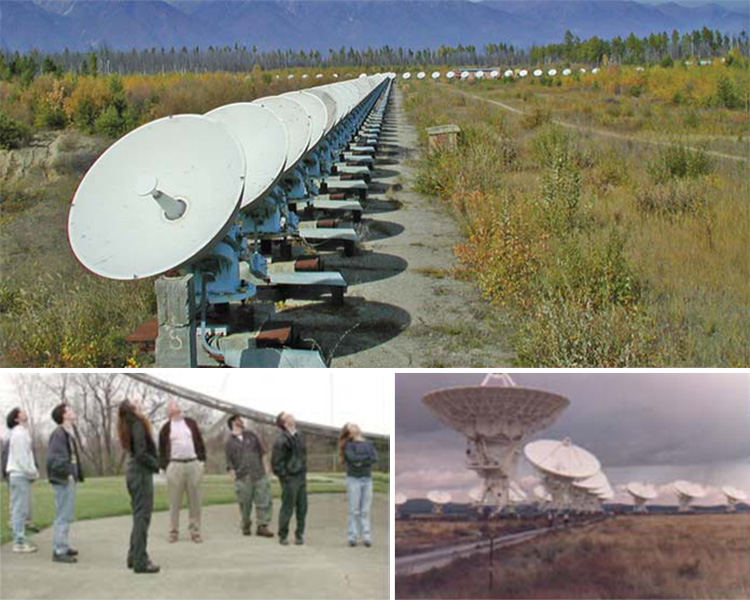 | |
Each of the antennae in the picture weighs 212 tons, and are as high as a 10-storey building and measure at least 25 meters across. | A radio telescope on Peach Mountain, in Dexter, Michigan |
Did We not make the earth a receptacle? (Surat al-Mursalat, 25)
 |
Isaac Newton |
The Arabic word "kifatan," translated as "receptacle" in the above verse, means "living things being gathered together and protected in their dwellings.” It can also mean “a place where living or inanimate things are gathered together” or “a place on which things are piled or collected.” "Kifatan" comes from the root word "kafata," which means "to collect, gather toward one, embrace."
With its gravitational force, the earth pulls human beings and everything else on it - living or inanimate - toward its center. It is very likely that the use of a verb meaning "to pull toward one" refers to this force of gravity. (Allah knows the truth.)
Thanks to the force of gravity that pulls animals, plants, human beings and everything else on Earth toward itself, people are able to walk on the ground, objects can remain where they are without flying off into the air, athmosphere encircles the Earth and rain falls on Earth.
Sir Isaac Newton, regarded as one of the greatest scientists ever, investigated this feature of the Earth. During his studies, he made one of the greatest scientific discoveries of all time. He wrote about gravity in his famous book, Philosophiae Naturalis Principia Mathematica (The Mathematical Principles of Natural Philosophy), first published in 1687. The Latin word "attraere" Newton used in discussing gravity also means "to attract, bring together."
The reference in the Qur'an to one of the Earth's four great forces, only defined in the 17th century, is just one of the proofs that the Qur'an was sent down from the Presence of Allah.
 |
"You will see the mountains you reckoned to be solid going past like clouds–the handwork of Allah Who gives to everything its solidity. He is aware of what you do." (Surat an-Naml, 88)
One possible interpretation of the above verse is that it may very well be a reference to the strength of the atom, the building block of all matter. It may allude to the orbit of electrons in the atom, which students all over the world are taught about in their daily science lessons. Looked at in the context of atoms, the use of the term "to everything its solidity" can be interpreted as referring to the solidity of the atom, which cannot be broken even if struck with a sledgehammer (Allah knows the truth). That is because objects themselves are not perfectly solid. Only the atom is perfectly solid.
For example, even if a vase is shattered, the atoms that make it up remain solid. A car may turn into a pile of junk after an accident, or a skyscraper may collapse after an explosion, but the atoms remain unwavering in their unity. Indeed, the situation remains the same whether it is a delicate flower or a tough piece of metal: the atoms that constitute matter do not fall apart or stray off-orbit. Therefore, even the most fragile-looking piece of matter is actually very solid in its Creation. The wisdom behind the reference to "everything" in the verse may well lie in the fact that the atom is the basis of all matter.
Very solid structures are even to be found in nuclear bombs, which work by splitting atomic bonds. In nuclear fission, the atomic nucleus is split and then divided into two smaller atoms. In the nuclear fusion technique, two small atoms are combined together to make one larger atom. For example, solar energy is manufactured in this way, by hydrogen being turned into helium. As a result, there is a constant cycle from matter to energy and from energy to matter, and there is a general solidity in the universe at the atomic level.
If one examines this verse of the Qur’an further, there may also be reference to the clouds of electrons around atomic nuclei, whose movement is likened to "mountains... going past like clouds." (Allah knows the truth.) The electrons in their orbits, in the atoms, that make up the “mountains” strongly resemble a cloud – this can be said about their appearance, not to mention their constant and rapid motion around the nucleus. Indeed, the orbiting electrons in the atom are regularly described as an "electron cloud" in contemporary scientific literature.7 The concept of an electron cloud is used in molecular physics, chemistry and quantum chemistry to describe the way they move in a manner similar to a cloud around the atomic nucleus.8
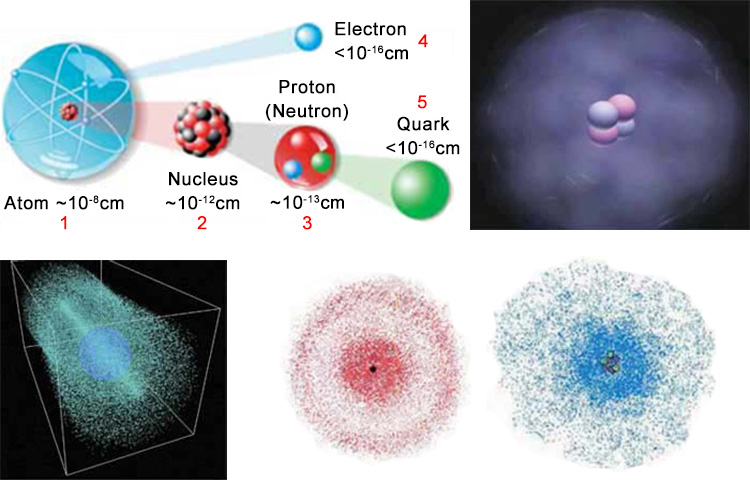 | ||
1. Atom | 3. Proton (Neutron) | 4. Electron |
The rapid movement of electrons around the atom leads to their resembling clouds. | ||
It is impossible to understand the structure of the atom and establish this cloud-like appearance of electrons without such high-tech devices as electron microscopes. The fact that the information provided fourteen centuries ago in the Qur'an matches the discoveries of advanced, present-day technology is one of the miracles of the Qur'an. It is also a manifestation of our Lord's titles of Alim (He Who knows all things), Fatir (the Creator) and Halik (He Who will see and arrange the existence of all things and Who creates accordingly, He Who creates from nothing).
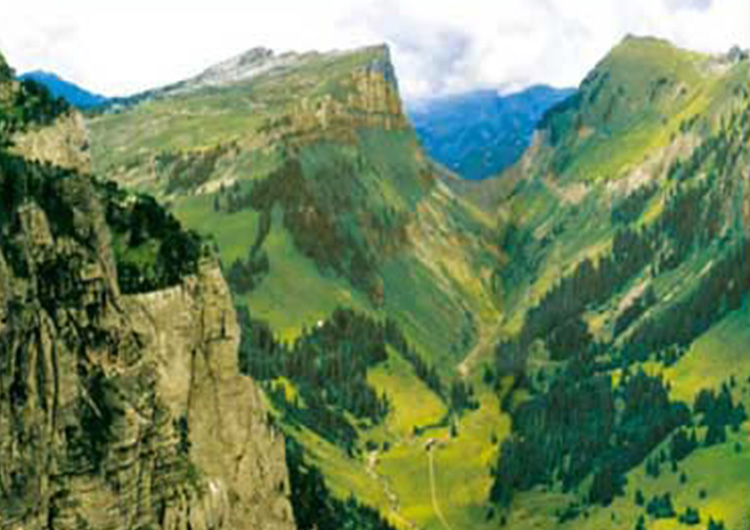 |
You see the mountains you reckoned to be solid going past like clouds - the handiwork of Allah who gives to everything its solidity. |
"By heaven furnished with paths " (Surat adh-Dhariyat, 7)
The Arabic word "alhubuki," translated as "furnished with paths" in the seventh verse of Surat adh-Dhariyat, comes from the verb "hubeke," meaning "to weave closely, to knit, to bind together." The use of this word in the verse is particularly wise and represents the current state of scientific knowledge in two aspects.
Firstly, the orbits and paths in the universe are so dense and intertwined that they constitute intersecting paths, just like the threads in a piece of fabric. The Solar System we live in is made up of the Sun, the planets and their satellites – along with heavenly objects such as meteors and comets, which are in constant motion. The Solar System moves through the galaxy known as the Milky Way, which contains 400 billion known stars.9 It is estimated that there are billions of galaxies. Miraculously, celestial bodies and systems revolve at speeds of thousands of kilometers an hour. They move through space without colliding with one another when logically, one would think they would collide with each other constantly.
 | ||
A. Inner Solar System | 1. Mercury | 7. Uranus |
Above left; the orbits of some of the bodies in the Solar System. Based on this picture and looking clockwise, it can be seen that the Solar System itself is part of even greater orbital movements. | ||
The science of astronomy was developed with the aim of mapping the positions and courses of stars. Meanwhile, the study of astro-mechanics was developed in order to determine the manner in which these complex motions actually work. Astronomers used to assume that orbits were perfectly spherical. The fact is, however, that heavenly bodies are known to follow mathematical shapes, such as spherical, elliptical, parabolic or hyperbolic orbits. Dr. Carlo Rovelli of the University of Pittsburgh says, "Our space in which we live is just this enormously complicated spin network."10
 | 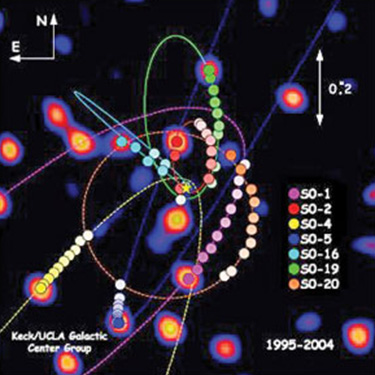 |
The picture above shows some of the complex movements of stars. | This picture shows the approximately annual movements of just seven stars in the Milky Way. |
Secondly, the description of the sky in the Qur’an - using a word meaning "woven" - may be a reference to the String Theory of physics. (Allah knows the truth.) According to this theory, the basic elements that comprise the universe are not point-like particles, but strings resembling miniature violin strings. These tiny, identical and one dimensional strings oscillating in the form of filaments are rather like loops in appearance. Modern-day thinkers assume that the origin of all the diversity in the universe lies in the way these “strings” operated at different levels of vibration, in the same way that violin strings produce different sounds with different vibrations depending on how they are plucked.11
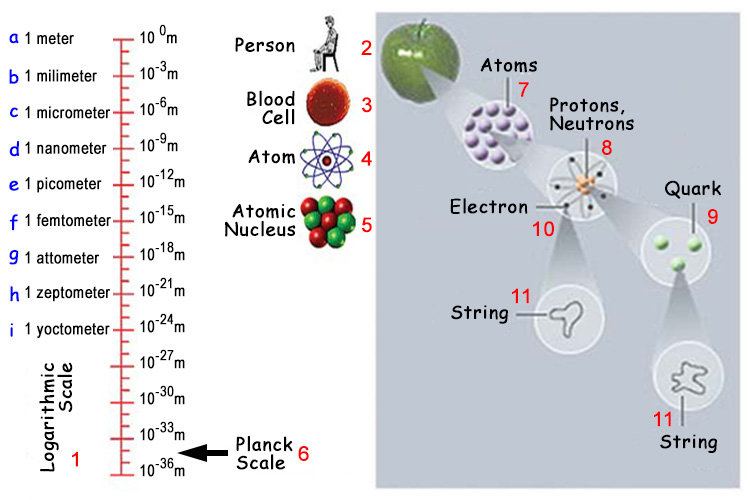 | |||
a. 1 meter 10 0 m | f. 1 femtometer 10-15 m | 2. Person | 7. Atoms |
Although it is not possible to see the size of the threads in the String Theory, famous theses - such as Einstein’s theory of general relativity and his ideas on quantum mechanics – can still be calculated mathematically. These strings, which scientists regard as the material from which space and time are woven, are just 1.6x10-35 m 0.000000000000000000000000000000000016 meters) in size.12 This, known as Planck's length, is the smallest known measurement, being just ten to twenty of the protons that make up the nucleus of that atom.13 If an atom were to be magnified to the size of the Solar System, each one of these strings would be no bigger than an average-sized tree.14 Also, we must constantly bear in mind that an atom is 100,000 times smaller than the smallest thing that can be seen with the naked eye. It is only when one remembers facts like these can a person truly grasps how extraordinary the atomic world really is.
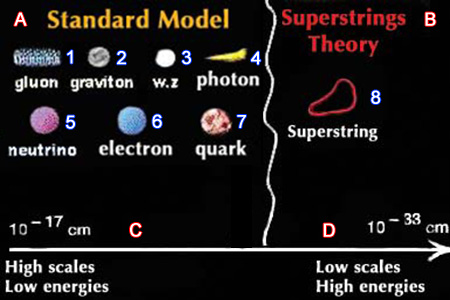 | ||
A. Standard Model | 1. Gluon | 5. Neutrino |
Professor of Physics Abhay Ashtekar from the University of Pennsylvania and Professor of Physics Jerzy Lewandowski from the University of Warsaw interpret the woven appearance of space as follows in an article titled "Space and Time Beyond Einstein":
In this theory, Einstein wove the gravitational field into the very fabric of space and time... The continuum we are all used to is only an approximation. Perhaps the simplest way to visualize these ideas is to look at a piece of fabric. For all practical purposes, it represents a two-dimensional continuum; yet it is really woven by one-dimensional threads. The same is true of the fabric of space-time. It is only because the "quantum threads" which weave this fabric are tightly woven in the region of the universe we inhabit that we perceive a continuum. Upon intersection with a surface, each thread, or polymer excitation, endows it with a tiny "Plank quantum" of area of about 10-66 cm2. So an area of 100 cm2 has about 1068 such intersections; because the number is so huge, the intersections are very closely spaced and we have the illusion of a continuum.15
An Article in the New York Times seeking an answer to the question "How Was the Universe Built?" contained the following lines:
 |
The University of Pittsburgh physicist Carlo Rovelli presents a model woven like a web in order to represent the microscopic architectural structure of the universe. |
Even the tiny quarks that make up protons, neutrons and other particles are too big to feel the bumps that may exist on the Planck scale. More recently, though, physicists have suggested that quarks and everything else are made of far tinier objects: superstrings vibrating in 10 dimensions. At the Planck level, the weave of space-time would be as apparent as when the finest Egyptian cotton is viewed under a magnifying glass, exposing the warp and woof.16
In his book Three Roads to Quantum Gravity, the theoretical quantum physicist Lee Smolin devotes one chapter to "How to Weave a String" and says this on the subject:
... Space may be 'woven' from a network of loops... just like a piece of cloth is 'woven' from a network of threads.17
In his book Our Cosmic Habitat the cosmologist and astrophysicist Prof. Martin Rees says:
According to our present concepts, empty space is anything but simple... and on an even tinier scale, it may be a seething tangle of strings.18
Allah describes the universe as being woven paths and orbits in verse 7 of Surat adh-Dhariyat – and this demonstrates that the Qur'an agrees with modern science. This perfect harmony between the Qur'an and present day scientific developments clearly reveals that the Qur'an is the word of our Lord, the Creator of all. He knows best about all things. Indeed, He asks a pertinent question in one particular verse:
"Will they not ponder the Qur'an? If it had been from other than Allah, they would have found many inconsistencies in it." (Surat an-Nisa’, 82)
Do they not see the birds suspended in mid-air up in the sky? Nothing holds them there except Allah. There are certainly signs in that for people who believe. (Surat an-Nahl, 79)
 |
1. Low Pressure Lift Force |
The tops of birds’ wings are curved, the bottoms are flat. This shape produces lower pressure on the top compared to the bottom. This difference in air pressure produces a lift force that enables the bird to rise in the air by beating its wings upward. |
Due to the force of gravity, all bodies which are airborne should eventually fall to earth, either quickly or slowly. Everything, living or otherwise, is subject to the Earth’s gravitational pull. But as a miracle of Allah, birds are able to resist this force and fly upward and downward in the air with extraordinary ease and agility. They maneuver in the air, and sometimes even fold their wings and glide through it with effortless grace and dignity. Even the minutest details which scientists have discovered in the bodies of birds - from their beautiful feathers to their powerful lungs, from the arrangement of the general physiology to the shape of their perfect wings - are equipped with special features and a faultless order which enables them to fly. A chick totally unaware of the act of flight and the laws of aerodynamics is born with the ability to fly. The chick launches itself downwards and begins to fly, just as if it knew its body was created for flight. This is not information that is taught subsequently nor is this something that a bird learns by trial and error. Amazingly, a bird knows it has the body structure needed to fly. Without any encouragement, it naturally possesses the courage to launch itself into the air and then flies without hitting the ground. This can only happen through Allah's inspiration.
The Arabic word "yumsikuhunna" translated as "holds" in verse 79 of Surat an-Nahl means "not letting them go, taking them, catching them, or holding them." The word is the present tense of the verb "amsaka," meaning "to catch with the hand, hold and pull back." With this word, our Almighty Lord reveals that He holds the bird in the air and that it flies by His command. Bird flight is still the subject of wide-ranging research by scientists. Having observed the perfection of bird flight, scientists use the avian body and avian flight ability as direct models in producing such vehicle as airplanes and jets.
 |
1. Lift Force |
(a) The air passing quickly around the bird's wings generates a lifting force. (b) The bird bends its wings to obtain greater lift. Air flowing over the wing is thus accelerated. (c) If the wing is bent perpendicular, the air is unable to flow easily towards the upper surfaces of the wing, and the bird loses speed and stalls. Through Allah's Inspiration, birds make use of the principles of aerodynamics as they fly. Birds use the principles of aerodynamic forces in flying. These techniques and actions are inspired in them by Allah. The tops of birds' wings are curved whilst the bottoms are flat. This shape produces lower pressure on the top compared to the bottom. This difference in air pressure produces a lift force that enables the bird to rise in the air by beating its wings upward. |
The above-mentioned verse may well be highlighting the manner in which birds comply with the aerodynamic laws created by Allah as they fly. The science of aerodynamics studies the behavior of solid bodies in a fluid environment such as air. For example, as a plane moves through the air, various forces emerge that affect its movement. In order for the plane to move as planned and not to run into any resistance, the plane is thoroughly tested beforehand against the resistance exhibited by the air. Its shape and movement is planned as a result of lengthy calculations, measurements and experiments.
Today, scientists are still astonished at how birds defy gravity with such skill and poise. Using no form of trial and error, they cope with the laws of aerodynamics in the most perfect manner. The use of the word "musakhkharatin" (suspended) in the verse to describe bird flight is an exceedingly specific choice of language, because it suggests that they have been "encouraged to a specific end, have had to do something, have submitted or bowed their heads, have bound themselves to Allah or have submitted to His laws". This is the implication contained in the word itself. In that way, the verse may be indicating the manner in which aerodynamic laws have a determining influence on bird flight. (Allah knows the truth.)
At first sight, there would appear to be nothing to make it difficult for birds to fly. But according to the laws of aerodynamics, any object flying in the air is subject to various different forces. The best-known of these are gravity, propulsion, drag and lift. In order for any meaningful flight to take place, these forces have to be balanced perfectly. The slightest imbalance in a bird would cause it to come crashing down to earth each time it tried to fly. For example, if gravity is stronger than the other forces, the bird will fall to earth. That is why the word in the verse is the best possible expression of the situation which we are examining here. The presence in the Qur'an of expressions containing such information at a time when no science of aerodynamics or mechanics existed, once again, reveals that the Qur'an is a divine text.
In addition to the aerodynamic perfection in bird flight, scientists are also researching the migration patterns of thousands of kilometers that they make. Ornithologists have today concluded that these are literally programmed in them. The way that young birds are able to undertake long and arduous journeys with no guide or previous experience is the most obvious example of this. The Arabic word "musakhkharatin" in the verse quoted above implies "being encouraged toward a specific target, being taken under command, being taken under submission," clearly revealing that birds obey the instructions they are given when following the directions set out for them. There is no possibility of birds, which are devoid of intellect and consciousness, managing to make their own calculations as they fly. Scientists today are in agreement that these extraordinary abilities in birds are "pre-programmed" in them. This is set out in an article in the journal Science:
There is good evidence that young birds are equipped with endogenous migratory programs, which tell them roughly how many days and/or nights that they must fly, and in what direction.19 (emphasis added)
In his book La Puissance et la Fragilité, Pierre Jean Hamburger from René Descartes University describes the extraordinary 24,000-kilometer journey made by the shearwater that lives in the Pacific Ocean:
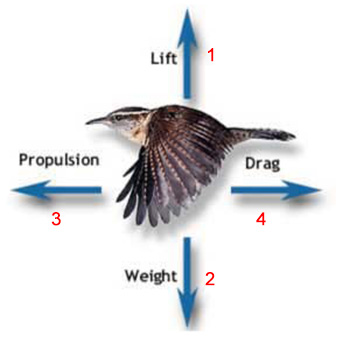 | |
1. Lift | 3. Propulsion |
The illustration shows the main forces acting on a bird during flight. | |
It sets out from the coast of Australia. From there it flies straight southward to the Pacific. Then it turns north and flies along the coast of Japan until reaching the Bering Sea where it can rest for a while. Following that break it sets off again, and this time heads south. Crossing the western coast of America, it arrives in California. It then crosses the Pacific to return to its starting point. The route and timing of this 15,000-mile (24,000-kilometer) figure '8' journey it makes every year never change. The journey in question lasts a whole six months, always coming to an end in the third week of September on the island it left six months before, at the nest it left six months before. What comes next is even more astonishing; after their return, the birds clean their nests, mate, and lay a single egg over the last 10 days of October. The chicks hatch out two months later, grow very fast and are cared for over three months until their parents set out on that stupendous journey. Two weeks later; around the middle of April, it is time for the young birds to take wing on their own journey. They follow exactly the same route as that described above, with no guide. The explanation is so obvious: These birds must have all the directions for such a journey within the inherited characteristics passed on within the egg. Some people may claim that birds navigate by the Sun and stars or follow the winds prevailing along their route on this journey out and back. But it is clear that these factors cannot determine the journey's geographical and chronological accuracy.20 (emphasis added)
Professor Peter Berthold, a famous ornithologist who has investigated bird migration for 20 years and president of the Max Planck Institute Ornithological Research Center, says the following about bird migration:
Every year an estimated 50 billion birds make migratory journeys, along a network of routes that encompasses the whole world. Sometimes travelling tens of thousands of kilometers, crossing continents and oceans, migratory birds have become so well adapted to this task that they can traverse the largest deserts and seas, the highest mountains and expanses of ice... migratory birds have comprehensive, detailed, innate spatio-temporal programs for successful migration. Such programs evidently enable even young, inexperienced birds to migrate alone, with no adult guide, to the species- or population-specific winter quarters that they have never seen before. As will be explained further below, they do this by "vector" navigation: referring to a vector composed of a genetically predetermined migratory direction and to a time-plan, also genetically predetermined, for the course of migration... It follows that the departure time is programmed by genetic factors... But how do birds "know" the direction in which to migrate, so that they will reach their specific winter quarters? Here, again data have been obtained that point to direct genetic control mechanisms. It has long been suspected that migration directions are innate... when displaced from the normal starting point, and still more crucially, when tested in orientation cages, migratory birds showed directional preferences practically identical to the normal ones, even if they had never migrated before. Now a number of experiments have provided evidence of the genetic determination of migration direction... Even these directional changes are evidently programmed endogenously to a great extent... With an innate pattern of migratory activity, the birds possess a genetically determined migration schedule. In combination with genetically determined migratory directions, as mentioned above, it guides even inexperienced individuals, migrating for the first time, "automatically" to their previously unknown winter quarters (vector navigation, using a vector composed of a time- and a direction-plan).21 (emphasis added)
In conclusion, although scientists are unable to fully account for it, they still agree that migration is pre-programmed behavior that birds possess from birth. Journeys lasting thousands of kilometers, the preparations made for these flights and birds’ ability to find their way and navigate during flight all take place by our Lord's choosing, as expressed in the above verse. The accuracy of all the information provided in the Qur'an is important evidence that this information has all been revealed by Allah.
 |
The air moving rapidly around the bird's wings produces the lift force. The bird bends its wings is thus accelerated. If it inclines its wings upward at a very steep angle, air cannot easily flow to the upper parts of the wings and the bird loses speed and stalls. Through Allah's inspiration, birds make use of the princles of aerodynamics as they fly. |
1 Henrik Stapelfeldt, "Electrons Frozen in Motion", Nature, 16 Aralık 2004, cilt 432, ss. 809-810; Adrian Cho, "Whispering Atoms", New Scientist, 16 Eylül 2000, cilt 2256, s. 15; Albert Stolow, David M. Jonas, "Multidimensional Snapshots of Chemical Dynamics", Science, 10 Eylül 2004, cilt 305, no. 5690, ss. 1575-1577.
2 http://en.wikipedia.org/wiki/Electron_cloud
3 http://casswww.ucsd.edu/public/tutorial/MW.htm
4 George Johnson, "How Is the Universe Built? Grain by Grain", The New York Times, 7 Aralık 1999; http://www.nytimes.com/library/national/science/120799sci-planck-length.html
5 http://theory.uwinnipeg.ca/users/gabor/symmetry/slide22.html
6 http://www.phys.unsw.edu.au/einsteinlight/jw/module6_Planck.htm
7 http://www.physlink.com/Education/AskExperts/ae281.cfm
8 http://www.pbs.org/wgbh/nova/elegant/everything.html
9 Abhay Ashtekar, Jerzy Lewandowski, " Space and Time Beyond Einstein", Rzeczpospolita, Nisan 2002; http://gravity.psu.edu/people/Ashtekar/articles/Rzeczpospolita_SaTBE.html
10 George Johnson, "How Is the Universe Built? Grain by Grain", The New York Times, 7 Aralık 1999; http://www.nytimes.com/library/national/science/120799sci-planck-length.html
11 Lee Smolin, Three Roads to Quantum Gravity, Basic Books, New York, 2001, s. 186.
12 Martin Rees, Our Cosmic Habitat, Princeton University Press, 2001, s. 107.
13 Rudiger Wehner, "Bird Navigation—Computing Orthodromes", Science, 12 Ocak 2001, cilt 291, no. 5502, ss. 264–265.
14 Pierre Jean Hamburger, La Puissance et la Fragilité, Flammarion Pub., Paris, 1972.
15 Peter Berthold, "Bird Migration: Introductory Remarks and Overall Perspective", Torgos, 1998, cilt 28, ss. 25-30; http://www.birds.org.il/show_item.asp?itemId=1211&levelId=811&template=209
16 http://www.forestpathology.org/wood.html; Wood Chemistry and Anatomy, 2005.
17 http://www.forestresearch.gov.uk/fr/INFD-6FMCUS; The Research Agency of the Forestry Commission, 2007.
18 Christophe Plomion, Gregoire Leprovost, Alexia Stokes, "Wood Formation in Trees", Plant Physiology, Aralık 2001, cilt 127, ss. 1513–1523.
19 Uwe Schmitt, "Chaffey, N.J. ed. Wood formation in trees—cell and molecular biology techniques", Annals of Botany, 2002, cilt 90, no. 4, ss. 545-546.
20 Julian Vincent, "Tricks of Nature", New Scientist, 17 Ağustos 1996, cilt 151, no. 2043, s. 39.
21 Julian Vincent, "Tricks of Nature", New Scientist, 17 Ağustos 1996, cilt 151, no. 2043, s. 40.